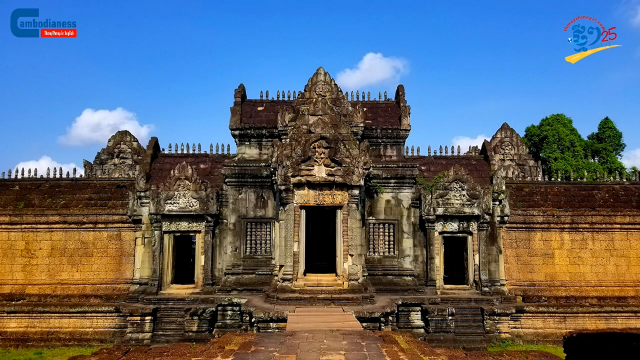Banteay Samre: a Beautiful Temple of the Angkor Wat Era

- By Long Ton
- July 31, 2022 8:13 PM
SIEM REAP — To reach the Banteay Samre temple that faces east, tourists must walk along a laterite causeway with dragon handrails on each side, and this, in the shade of the surrounding trees and an ambiance of tranquillity.
Two ponds located along the gate are hidden by the forest. An ancient road going from the Yasotataka—the man-made water reservoir also known as East Baray—leads to the temple’s western gate where large stone pillars now dilapidated adorn the way leading to its entrance. The designs on these pillars share similarities with the pillars along the paths to the entrances of the Chrey temple in Siem Reap Province’s Svay Loeu district and commune, and the Beng Mealea temple southeast of Phnom Kulen.
_1659273355.png)
The Banteay Samre temple is a building with a single tower connected by a structure extending to the east and two hoa trai, or ancient libraries, at the southeast and northeast corners. Of the loggia, only some parts of the wall and pillars still stand today. Experts and archaeologists’ research has led to conclude that the loggia’s roof was once tiled.
It should be noted that, as the inner roof components of the loggia were restored, finials (pointy roof ornaments) were restored to its original location. After studying traces on the stone structures, windows and walls located inside and outside, researchers have concluded that construction of this temple had not originally been completed.
Even though there is no stone inscription to confirm this, based on to the style of its artwork and architecture that is very similar to that of the Angkor Wat monument, experts have concluded that Banteay Samre is a Hindu temple built in the middle of the 12th century.
_1659273394.png)
The sculptures on the lintels and gable are still in good condition, and most of them are lively and bouncy as if they were dancing outside their frames.
Sculpted elements at the Banteay Samre temple illustrate Hindu scenes and beliefs. They include scenes of Vishnu sitting on Makara, a mythical sea dragon, Vishnu killing Prithu, the story of the Churning of the Ocean of Milk, depictions of Krishna, and so on. Sculptures of Rama and Vishnu can also be seen on important lintels along the temple’s structure.
If we look at the interior of the central tower, we can see flowers as well as human beings’ activities and animal characters depicted in detail.
_1659273433.png)
According to the documents of Maurice Glaize—a French architect and archaeologist who was the conservator of Angkor from 1937 to 1945 and who personally worked at restoring the Banteay Samre temple—after clearing the forest to pave the way for the restoration of the temple in 1930, the restoration of this temple finally took place from 1936 to 1944.
During excavations in the 1930s, the restoration team discovered a rectangular “stone box” that some researchers believed was a stone coffin. However, since there was a square hole at the top of the box and a hole at the bottom, others rejected this theory. This stone box is now displayed on the front porch of the central temple structure.
_1659273472.png)
To reach this temple, visitors can use the road from Preah Dak village in Banteay Srey district and then go east for about 2 kilometers, which will take them to the northern gate of Banteay Samre temple.
All photos provided by Long Ton
Originally written in Khmer for ThmeyThmey25, this story was translated by Cheng Ousa for Cambodianess.















